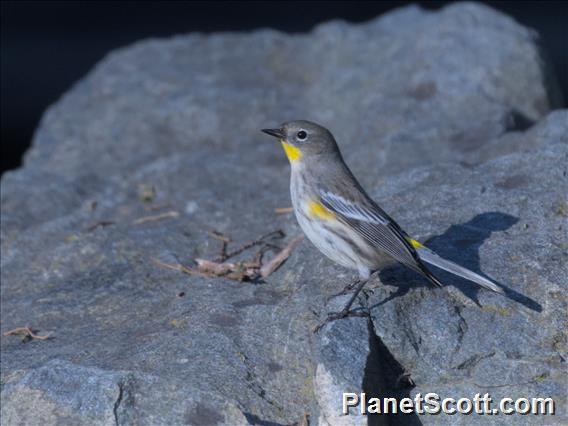Yellow-rumped Warbler (Setophaga coronata)


About Yellow-rumped Warbler (Setophaga coronata)
- Kingdom: Animals
- Phylum: Chordates
- Class: Birds
- Order: Perching Birds
- Family: New World Warblers
The yellow-rumped warbler is a regular North American bird species that can be commonly observed all across the continent. Its extensive range connects both the Pacific and Atlantic coasts of the U.S. as well as Canada and Central America, with the population concentrated in the continent's northern reaches during the breeding season and migrating southwards to southern North and Central America in the winter. It generally prefers coniferous forests or mixed coniferous-deciduous forests as its breeding habitat, while during the winter it can be found inhabiting more open areas such as shrublands that offer food resources. The yellow-rumped warbler is primarily insectivorous, though the species does eat fruits such as juniper berries as well, especially in winter.
Source: Wikipedia
Trips
Visits
-
1995-06-15
Mission - My Backyard, United States of America -
2005-05-15
King's Canyon National Park, United States of America -
2007-01-05
Bernal Hill, United States of America -
2007-01-13
Cosumnes River Preserve, United States of America -
2007-04-09
Anza-Borrego Desert State Park, United States of America -
2008-01-06
Singayta, Mexico -
2008-01-17
Mission Creek, United States of America -
2008-02-17
San Jose del Cabo - Estuary, Mexico -
2008-09-20
Emigrant Wilderness, United States of America -
2008-12-06
Colusa National Wildlife Refuge, United States of America -
2009-01-22
Cay Caulker, Belize -
2009-02-12
Corn Islands, Nicaragua -
2009-04-04
Bernal Hill, United States of America -
2009-05-08
Burnidge Forest Preserve, United States of America -
2009-05-09
Nelson Lake Forest Preserve, United States of America -
2010-01-03
Sacramento National Wildlife Refuge, United States of America -
2010-02-16
El Rosario, Mexico -
2010-02-20
Temescaltepec, Mexico -
2010-05-27
Kenai Peninsula, United States of America -
2010-10-30
Miller Meadow Forest Preserve, United States of America -
2010-11-06
Fort Mason, United States of America -
2011-11-19
Ferry Plaza, United States of America -
-
2012-07-09
Sax-Zim Bog, United States of America -
2012-07-12
Yellowstone National Park, United States of America -
2012-12-02
Lake Merced , United States of America -
2012-12-06
Solano County Farmlands, United States of America -
2012-12-13
Heron's Head Park, United States of America -
2013-03-17
Lake Merced , United States of America -
2013-03-23
Coyote Point County Park--harbor and marsh, United States of America -
2013-03-24
Fort Mason, United States of America -
2013-04-19
Bolivar Peninsula, United States of America -
2013-10-12
Redwood Valley, United States of America -
2013-11-29
Lake Merced , United States of America -
2013-12-01
Heron's Head Park, United States of America -
2013-12-07
Golden Gate Park - San Francisco Botanical Garden, United States of America -
2014-01-01
Heron's Head Park, United States of America -
2014-01-14
Candlestick Park, United States of America -
2014-02-01
San Pedro Valley County Park, United States of America -
2014-02-15
Lake Merced , United States of America -
2014-02-16
Golden Gate Park - North Lake, United States of America -
2014-02-16
Golden Gate Park - San Francisco Botanical Garden, United States of America -
2014-02-22
Santa Fe Grade, United States of America -
2014-02-22
Panoche Valley, United States of America -
2014-03-01
Fort Mason, United States of America -
2014-03-08
Tule Elk State Reserve, United States of America -
2014-03-09
Los Angeles County Arboretum and Botanic Garden, United States of America -
2014-03-09
Hahamongna Watershed Park, United States of America -
2014-03-22
Baker Beach, United States of America -
2014-04-06
Delta Meadows State Park, United States of America -
2014-05-08
Pinery Canyon Rd. (grasslands section only), United States of America -
2014-05-09
Cave Creek Canyon--Southwestern Research Station, United States of America -
2014-05-10
Pinery Canyon, United States of America -
2014-05-11
Miller Canyon, United States of America -
2014-07-18
Nome-Kougarok Road, United States of America -
2014-07-21
Seward, United States of America -
2014-09-23
Redwood Valley, United States of America -
2014-10-02
Golden Gate Park - San Francisco Botanical Garden, United States of America -
2014-11-29
Lafayette Park, United States of America -
2014-12-08
Golden Gate Park - San Francisco Botanical Garden, United States of America -
2014-12-27
Heron's Head Park, United States of America -
2014-12-28
Glen Canyon Park, United States of America -
2015-01-01
Candlestick Park, United States of America -
2015-01-03
Woodward Park, United States of America -
2015-01-04
Panoche Valley, United States of America -
2015-01-17
Lafayette Park, United States of America -
-
-
-
2015-03-13
Holbrook Palmer Park, United States of America -
-
-
-
-
-
-
-
-
-
-
-
-
-
-
-
-
-
-
-
-
-
-
-
-
-
-
-
-
-
-
-
-
-
-
-
-
-
-
-
-
-
-
-
-
-
-
-
-
-
-
-
-
-
-
-
-
-
-
-
-
-
-
-
-
-
-
-
-
-
-
-
-
-
-
-
-
-





